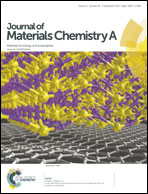Biocatalytic Janus membranes for CO2 removal utilizing carbonic anhydrase†
Abstract
A novel hydrophilic–superhydrophobic biocatalytic membrane was developed for CO2 capture with a gas–liquid membrane contactor. This “Janus” membrane contains a layer of hydrophilic carbon nanotubes (CNTs) coated on a fluorosilane treated superhydrophobic membrane support. Carbonic anhydrase (CA) was then immobilized on the hydrophilic CNT side, which was located at the CO2–solvent interface within a gas–liquid membrane contactor, whilst the superhydrophobic porous side of the membrane was oriented towards the gas phase. This “Janus” configuration ensured that the immobilized CA remained hydrated, and minimized the CO2 diffusion length in the solvent. The CNT coating layer showed good integrity and adhesion to the membrane, and the effect of superhydrophobic treatment on the porous structure of the membrane was negligible. The p-NPA assay results revealed that up to 30% CA activity was retained after immobilization. Further, the CO2 hydration test confirmed that the immobilized CA possessed significantly improved catalytic efficiency when compared with the equal amount of free CA. Effective regeneration of the enzyme coating was demonstrated over five cycles. The novel “Janus” membrane developed in this study exhibits great potential to be used as an immobilization support for a wide variety of enzymes not only CA for CO2 capture but also other types of enzymes in different applications.


 Please wait while we load your content...
Please wait while we load your content...